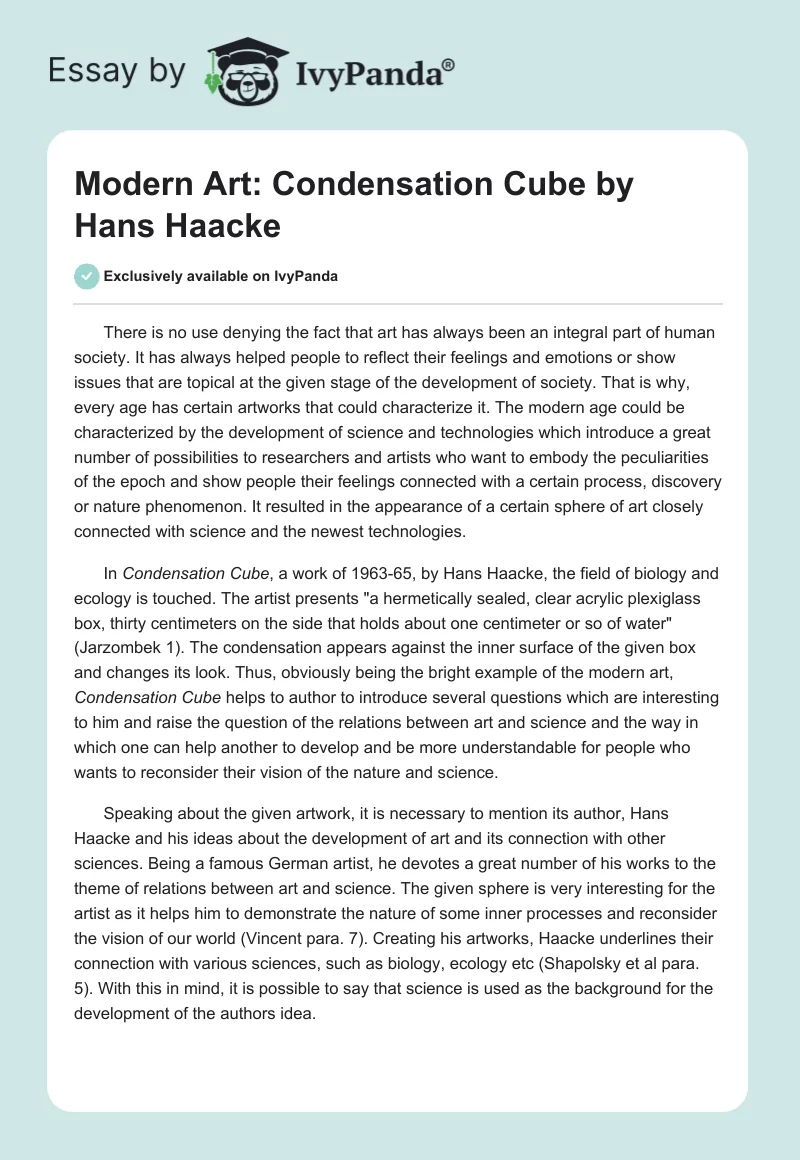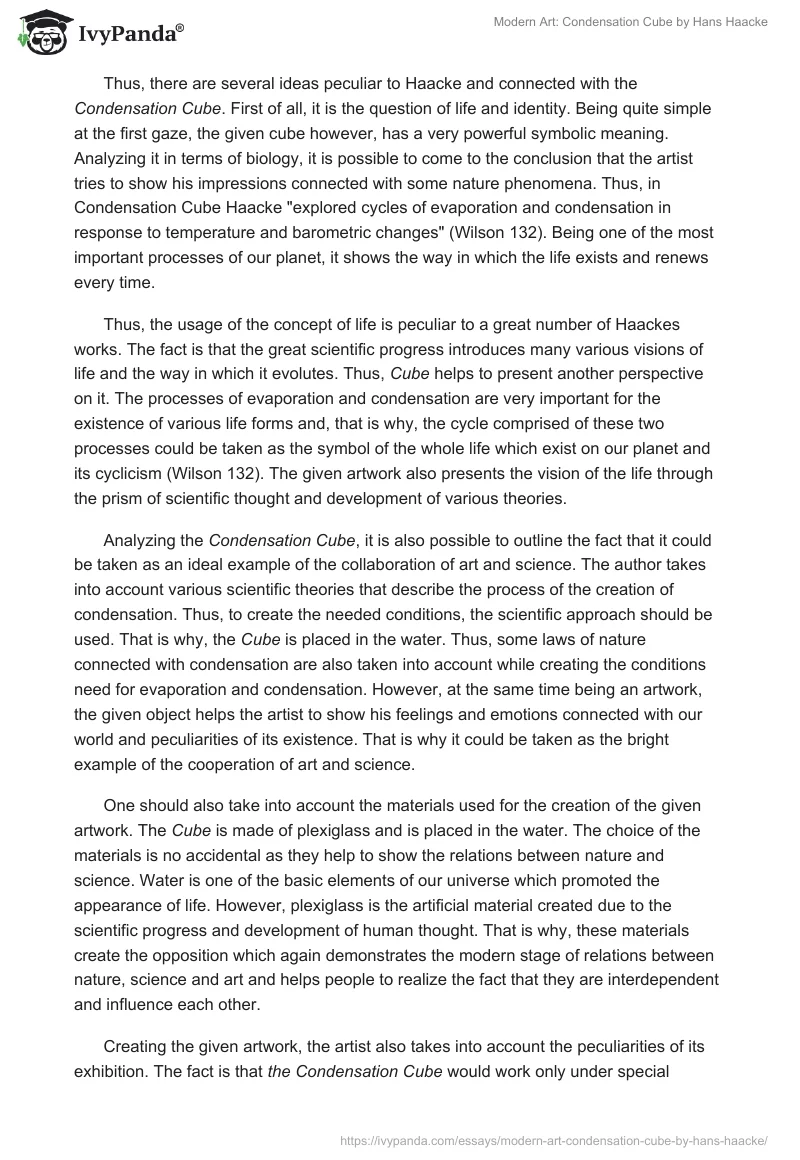There is no use denying the fact that art has always been an integral part of human society. It has always helped people to reflect their feelings and emotions or show issues that are topical at the given stage of the development of society. That is why, every age has certain artworks that could characterize it. The modern age could be characterized by the development of science and technologies which introduce a great number of possibilities to researchers and artists who want to embody the peculiarities of the epoch and show people their feelings connected with a certain process, discovery or nature phenomenon. It resulted in the appearance of a certain sphere of art closely connected with science and the newest technologies.
In Condensation Cube, a work of 1963-65, by Hans Haacke, the field of biology and ecology is touched. The artist presents “a hermetically sealed, clear acrylic plexiglass box, thirty centimeters on the side that holds about one centimeter or so of water” (Jarzombek 1). The condensation appears against the inner surface of the given box and changes its look. Thus, obviously being the bright example of the modern art, Condensation Cube helps to author to introduce several questions which are interesting to him and raise the question of the relations between art and science and the way in which one can help another to develop and be more understandable for people who wants to reconsider their vision of the nature and science.
Speaking about the given artwork, it is necessary to mention its author, Hans Haacke and his ideas about the development of art and its connection with other sciences. Being a famous German artist, he devotes a great number of his works to the theme of relations between art and science. The given sphere is very interesting for the artist as it helps him to demonstrate the nature of some inner processes and reconsider the vision of our world (Vincent para. 7). Creating his artworks, Haacke underlines their connection with various sciences, such as biology, ecology etc (Shapolsky et al para. 5). With this in mind, it is possible to say that science is used as the background for the development of the authors idea.
Thus, there are several ideas peculiar to Haacke and connected with the Condensation Cube. First of all, it is the question of life and identity. Being quite simple at the first gaze, the given cube however, has a very powerful symbolic meaning. Analyzing it in terms of biology, it is possible to come to the conclusion that the artist tries to show his impressions connected with some nature phenomena. Thus, in Condensation Cube Haacke “explored cycles of evaporation and condensation in response to temperature and barometric changes” (Wilson 132). Being one of the most important processes of our planet, it shows the way in which the life exists and renews every time.
Thus, the usage of the concept of life is peculiar to a great number of Haackes works. The fact is that the great scientific progress introduces many various visions of life and the way in which it evolutes. Thus, Cube helps to present another perspective on it. The processes of evaporation and condensation are very important for the existence of various life forms and, that is why, the cycle comprised of these two processes could be taken as the symbol of the whole life which exist on our planet and its cyclicism (Wilson 132). The given artwork also presents the vision of the life through the prism of scientific thought and development of various theories.
Analyzing the Condensation Cube, it is also possible to outline the fact that it could be taken as an ideal example of the collaboration of art and science. The author takes into account various scientific theories that describe the process of the creation of condensation. Thus, to create the needed conditions, the scientific approach should be used. That is why, the Cube is placed in the water. Thus, some laws of nature connected with condensation are also taken into account while creating the conditions need for evaporation and condensation. However, at the same time being an artwork, the given object helps the artist to show his feelings and emotions connected with our world and peculiarities of its existence. That is why it could be taken as the bright example of the cooperation of art and science.
One should also take into account the materials used for the creation of the given artwork. The Cube is made of plexiglass and is placed in the water. The choice of the materials is no accidental as they help to show the relations between nature and science. Water is one of the basic elements of our universe which promoted the appearance of life. However, plexiglass is the artificial material created due to the scientific progress and development of human thought. That is why, these materials create the opposition which again demonstrates the modern stage of relations between nature, science and art and helps people to realize the fact that they are interdependent and influence each other.
Creating the given artwork, the artist also takes into account the peculiarities of its exhibition. The fact is that the Condensation Cube would work only under special conditions needed for the beginning of certain processes. Besides, “in almost all art museums, the temperature is set at a cool 65 degrees Fahrenheit, which means that at a relative humidity of about 45 percent” (Jarzombek 1). Plexiglass is a bad thermal isolator, which means that the temperature is the same as it the atmosphere and the conditions for the evaporation and condensation are created. With this in mind, it is possible to say that the peculiarities of the exhibition have the great impact on the whole artwork and influences the viewers who look at it.
With this in mind, it is possible to say that the choice of the given materials is quite relevant. It has already been mentioned that it helps to outline some peculiarities of the relations between nature, science and art. However, it the choice has also been made in accordance with some important scientific processes that helped the Condensation Cube to work and produce the needed effect on people who want to see it. The relevance of the given choice is also proved by the fact that the cube looks modern which is one of the main peculiarities of all art of our epoch. The artist manages to create the best possible choice.
It should also be said that the given artwork is of great interest for people who want to enjoy the Haackes works and personally for me. The fact is that it demonstrates some very important processes in the way which is very understandable and clear. Looking at the Condensation Cube one realizes the power of nature, science and art and the way in which they could be combined. It is one of the most important aspects of the whole work. Even if a person does not have the idea how these issues could cooperate and interpenetrate, the given artwork could help him/her to see some process and reconsider the existing approach. Finally, it could also be taken as the clearest and the most understandable work of the given author as there is no need in a certain background if a person wants to understand it and get the idea of the authors vision of the world.
With this in mind, it is possible to make a certain conclusion. It should be said that the modern world could be characterized by the blistering development of various branches of science and technologies. Being the soul and spirit of any epoch, artists are not able to ignore these processes and they create new artworks that reflect relations between science and art, showing people the possibility of their collaboration and interchange. Haackes Condensation Cube is one of these works. It shows the way in which some very important natural process happen and how laws of nature and science could be united in a single artwork That is why, it is possible to say that Haacke manages to create the masterpiece which touches such questions as life and identity, art and science. Cube helps people to believe in the integration of these two issues, their common character and great perspectives awaiting them.
Works Cited
Jarzombek, Mark. Haacke’s condensation cube: the machine in the box and the travails of architecture. n.d. Web.
Shapolsky et al. Hans Haacke. Institutional Critique. n.d. Web.
Vincent, Alice. “Who is Hans Haacke, the new Fourth Plinth artist?”. Telegraph. 2015. Web.
Wilson, Stephen. Information Arts. London: MIT Press, 2002. Print.


